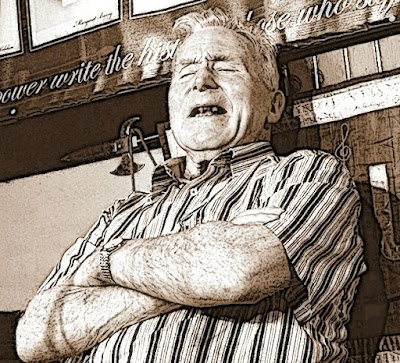I recently acquired a copy
of Finally Meeting Princess Maud by Seamus Dunleavy and Shirley
Thompson. The book was first published in 2006 by the Warwickshire-based publisher
of local history publications, Brewin Books. It is the co-written autobiography
of Mayo born wrestler and business man Seamus Dunleavy. Having enjoyed some of
Shirley’s other books about well-known local personalities, such as her trilogy
written with Pat Roach, I had the pleasure of meeting her earlier this year to help
with research into her latest work to be published later in 2017 and I came
away from our meeting with a copy of Finally
Meeting Princess Maud.
Written in a personable
style, the book recalls Seamus Dunleavy’s memories in a conversational manner,
for the reader it is like being in the room with Seamus as he takes a trip down
Memory Lane with commentary from Shirley putting each chapter into context.
The book begins with his
childhood on Barrack Street in the County Mayo village-town of Charlestown.
Born in 1934, Seamus grew up in impoverished conditions with his mother
struggling to feed and clothe the family whilst his father was working away in
England as a carpenter. It is a familiar story no doubt for working-class Irish
Catholics of Seamus’s generation, though worth hearing for the younger
generations who have no conception of just what life was like for families
living in real conditions of poverty.
Yet Seamus makes no appeal for
sympathy or sentimentality and his recall is matter-of-fact, dignified, often
humorous, warm and always entertaining. If indulgences and luxuries were few
and far between for the Dunleavy family of Barrack Street, Seamus found his
treasure in relationships with family and friends - the book is packed with
anecdotes of the people he has known and from the start one finds oneself
thinking “this is a nice fellah”.
Some autobiographies tend to
skip through childhood very briefly but for Seamus his memories are detailed
and of great interest and value. This includes the story of his youth in
Charlestown and migration to England in 1952 on board the famous Princess Maud of Wales to Liverpool
docks. The modest B & I Line
freight ship Princess Maud may not
have reached a place in popular consciousness as prominent as the Empire Windrush which brought Jamaican
migrants to England around the same time, but according to Seamus it has a
legendary reputation amongst Irish migrants of the early 1950s:
“I had heard about Princess Maud, all of my life, from the
immigrants around Charlestown – the rough conditions, seasickness, fights,
dancing on deck, hopelessness – most leaving with nothing but the fare – to the
farmlands of Lincolnshire.”
Seamus’s recollections of
living and working in Liverpool also have great historic value for us today in
contributing to the story of the Irish diaspora. He tells of the life of
labourers on the docks and work in factories, the basic housing, the trams and
double-decker buses, cinemas, Merseyside landmarks, popular music and the
football rivalry between Liverpool and Everton. It was in Liverpool that Seamus
joined a club called Duffy’s Boxing Club
in Litherland and on deciding that his physique was better suited to wrestling,
he subsequently joined the Amateur Wrestling club at the Pegasus Club. Seamus tells of the delight of his parents when he
sent them a copy of the Bootle Times with the story of his selection for the All England Championships.
In the late 1950s Seamus
moved to Birmingham and worked at Hams Hall near Coleshill before finding digs
on Wenman Street, Balsall Heath and later moving to Birchfield Road in Perry
Barr. His life became a mixture of hard work and craic whilst pursuing his love
of wrestling up and down the country. In 1958 he became a professional
wrestler, combined with working on the door at the Shamrock.
Seamus’s life in Birmingham
through the 1960s and subsequent decades is a fascinating read. The book tells
how he coached fellow Brummie Pat Roach and other local wrestlers, how he
became a landlord offering bedsits which were a cut above the rest (sinks in
the rooms) and how he ran several nightclubs in the city including the Talk of the Town, the Speak Easy, Daddy Longlegs, the Cascades and
Peter Rabbit. Seamus also recalls to Shirley the traumatic night in 1968 that
an unknown assailant in a donkey-jacket shot him as he arrived home in his car.
In spite of this event and other scrapes with trouble, Seamus Dunleavy
had a long and successful career, most famously as a wrestler and then as a
business man. He married Mary Griffin who he first met at a Saint Patrick’s
Night Dance in Hurst Street. They were engaged in July 1961 and married at
English Martyrs Church on 16 April 1963 with a reception at the Mermaid Hotel
on Stratford Road. The couple had three children, Shamus, Russell and Tracey.
Finally Meeting
Princess Maud
is a great read and well worth seeking out a copy. As well as telling a
fascinating story of a journey from hardship to success, it is packed with cultural
and geographical references from both Ireland and the West Midlands which will
have strong resonance to the local Irish community. Many will recognise local
landmarks and personalities now gone and most will also be familiar with the
journey of the Irish immigrant to England in the 1950s which Seamus Dunleavy’s
life-story exemplifies in its own unique way.
Published
by Brewin Books Ltd (www.brewinbooks.com)
ISBN
1 85858 284 9








